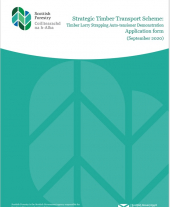A Guide to Improving Timber Transport

This document provides a guide to improving timber transport in Scotland and outlines previous case studies throughout Scotland.
The 20th century was a period of unprecedented afforestation in Scotland and the amount of home-grown timber we produce is increasing as these forests mature. From 1976 to 2012, the timber output from our forests multiplied from under 1 million to over 6 million tonnes per year. The forecast is for this to continue to rise to around 10 million tonnes per year by 2030.
Meanwhile, the minor road network that serves rural Scotland has remained much the same. The capacity of the road infrastructure to take timber haulage can be limiting. Narrow roads are a challenge for articulated vehicles, while passing places tend to be small and are few and far between. On more fragile roads, there is a risk that heavy traffic may break-up the thin tarmac surface leaving the local authorities with high repair costs. A significant increase in heavy traffic on minor roads can also create disturbance for rural communities particularly where vehicles pass through small towns and villages.
Sustainable haulage is a critical part of the timber supply chain, moving logs from forests to the processors with minimal impact on roads, communities and the environment.
File Name
improving-timber-transport.pdf
Category
File Size
355.56 KB
File Type
application/pdf
Version
1


